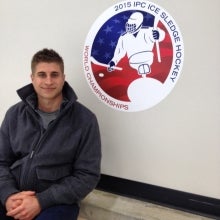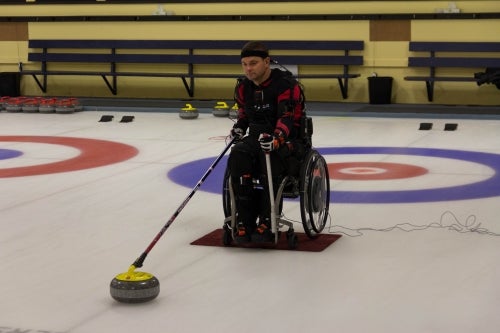In the “Silicon Valley of Canada” there’s no shortage of inspiration for graduate research. For Brock Laschowski, a Master’s student in the Faculty of Engineering’s Department of Mechanical and Mechatronics Engineering, that inspiration came in a sport with the top athletes, but little research: wheelchair curling.
“That was very exciting because there was so much room to innovate,” he says.

Laschowski contacted Curling Canada to find out more about the sport and discovered two things: one, it was relatively new; and two, Canada has the top wheelchair curling program in the world, with the reigning Paralympic champs.
“All the stars aligned,” says Laschowski, who is developing the first-ever biomechanical model of a wheelchair curler. A "forward dynamics" model, it has the unique ability to predict performance without requiring experimental data.
Using an engineering technique known as “optimal control,” Laschowski is looking at how the central nervous system controls the body when a wheelchair curler throws a stone.
He also used advanced medical imaging to scan wheelchair curlers to recreate an athlete digitally. Then, he tracked how the athlete moved to form a complete model, allowing him to quantify the joints torques during play. The model is so specific it measures how much force is on each joint, such as the shoulder and wrist, when an athlete throws a curling stone, helping improve performance and prevent injury.

Laschowski’s research, done in collaboration with the Canadian Sport Institute Ontario, will help wheelchair curlers learn optimal body and chair positioning, improve equipment design and understand the demands on the central nervous system, says Wendy Morgan, manager for Canada’s national team program.
“Any time a high performance program has access to new knowledge that can contribute to our ability to be ‘world leading’ in our sport, it is very exciting,” she says.
The research is an exciting first step towards developing a biomechanical model for wheelchair curling that will keep Canada’s tradition of Paralympic podium performances, says Dr. Steven Dilkas, the team’s lead physician. “Sport science and engineering are invaluable to the success of athletes at the elite level,” he says.
Laschowski hopes his research will develop wheelchair curling so seniors, children and those with physical disabilities can also enjoy the sport. He expects to graduate in the spring and is doing his research alongside Dr. Naser Mehrabi, a post-doctoral scientist in engineering, and Dr. John McPhee, the Canada Research Chair in Biomechatronic System Dynamics.
“Biomechatronics is really the future for sports research,” says Laschowski, adding those looking to pursue the program don’t need to look any further than Waterloo for quality programs in the field. “Waterloo is really considered the Silicon Valley of Canada. It is the hub for engineering and innovation.”





